
Heldenplatz is a public space in front of the Hofburg Palace in Vienna, Austria. Located in the Innere Stadt borough, the President of Austria resides in the adjoining Hofburg wing, while the Federal Chancellery is on adjacent Ballhausplatz.

Johann Philipp, Graf von Cobenzl was a statesman of the Habsburg monarchy and the Austrian Empire.

The Palais Lanckoroński was a palace in Vienna, Austria, located at Jacquingasse 16-18, in the Landstraße District. It was constructed in 1894-95 for Count Karol Lanckoroński and his family as a personal residence, and it housed the count's enormous art collection. The palace was built in a neo-baroque style by the theatre architects Ferdinand Fellner and Hermann Helmer. The building was three stories high, set back from the street, and protected by a wall with double gates. The entrance hall was wood panelled, two stories high, and decorated with portraits of the family. Other festive halls were decorated with frescoes and luxurious gobelin tapestries from the 17th century. Precious paintings, furniture and sculpture from different eras were arranged to form themed ensembles in the various rooms, with the rooms named to reflect the collection housed within. The palace was severely damaged in World War II, and was torn down in the 1960s.

Schloß Pötzleinsdorf or Schloss Pötzleinsdorf is a former palace in Pötzleinsdorf, Vienna. It is currently being used as a primary school.
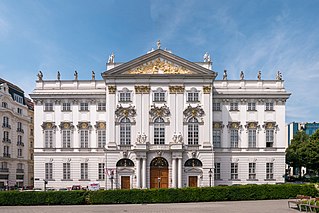
Palais Trautson is a Baroque palace in Vienna, Austria, located at Museumstraße 7. It was once owned by the noble Trautson family.

Palais Schwarzenberg is a Baroque palace in front of Schwarzenbergplatz, Landstraße, the 3rd district of Vienna, Austria. It is owned by the princely Schwarzenberg family.

Palais Kinsky is a Baroque palace in central Vienna, Austria. It was originally built for Count Wirich Philipp von Daun, the garrison commander whose son Leopold became a Field Marshal of Empress Maria Theresa. The palace was later bought by the Kinsky family of Bohemia, and it is sometimes called the Palais Daun-Kinsky.

Palais Auersperg, originally called Palais Rosenkavalier, is a Baroque palace at Auerspergstraße 1 in the Josefstadt or eighth district of Vienna, Austria.

The New Palace is a palace situated on the western side of the Sanssouci park in Potsdam, Germany. The building was begun in 1763, after the end of the Seven Years' War, under King Friedrich II and was completed in 1769. It is considered to be the last great Prussian Baroque palace.

The House of Sinzendorf was a German noble family with Upper Austrian origin, not to be confused with the Lower Austrian House of Zinzendorf. The family belonged to prestigious circle of high nobility families, but died out in 1822 in the male line.
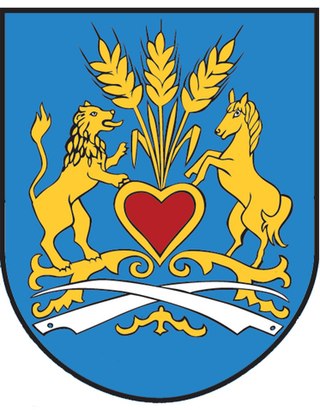
Inzersdorf was before 1938 an independent municipality, and is now a part of the 23rd Viennese district Liesing.
Johann Karl, Count Chotek of Chotkow and Wognin was a Bohemian-Austrian chancellor.
The following is a timeline of the history of the city of Vienna, Austria.
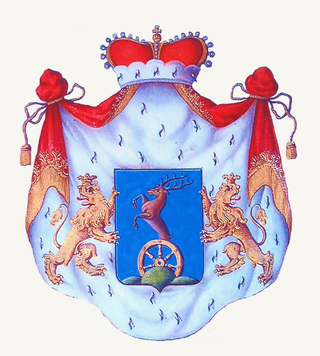
The House of Pálffy, also known as Pálffy von Erdöd, Pálffy de Erdöd, or Pálffy of Erdöd, is the name of an old Hungarian noble family, later incorporated into Austrian nobility. Members of the family held significant positions in the Habsburg monarchy.
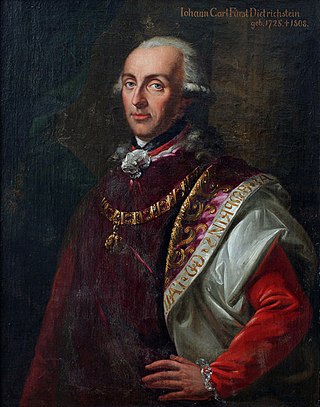
Karl Johann Baptist, Prince of Dietrichstein, was a German prince, member of the House of Dietrichstein, 7th Prince (Fürst) of Dietrichstein zu Nikolsburg, Princely Count of Tarasp, Baron (Freiherr) of Hollenburg, Finkenstein and Thalberg.

The following outline is provided as an overview of and topical guide to Vienna:
The Neupauer-Breuner Palace, known in German as Palais Neupauer-Breuner and sometimes referred to only as Palais Breuner by locals, is a Baroque building situated at Singerstrasse 16 in the first district of Vienna in Austria.
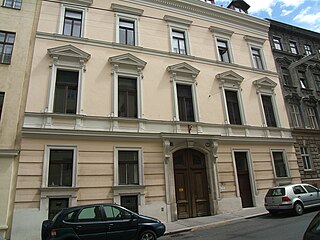
The Palais Apponyi is a palatial building in the district of Wieden in Vienna, Austria. Its address is Johann-Strauss-Gasse 7.
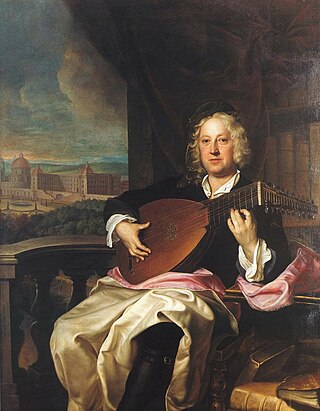
Count Johann Adam von Questenberg was an Austrian nobleman, Reichshofrat, amateur musician, and patron of the arts. He was a councilor of the Imperial Court in Vienna from 1702 to 1735. He organised concerts at his palaces in Vienna and Jarmeritz, and commissioned compositions by contemporary composers. He made his palace a music centre of Central Europe.

Melchior Friedrich, Count of Schönborn-Buchheim, was a German politician who served as a Minister of State of the Electorate of Mainz. After his death, four of his sons became German Prince-Bishops.



















